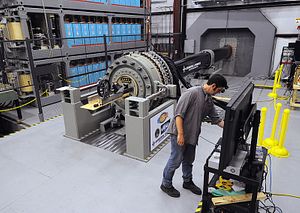As discussed in last week’s column, Stephen Biddle and Ivan Oelrich have made a significant contribution to the literature on the future military balance in the Western Pacific. As with any such analysis, however, their article offers as many questions as it does answers. We can break these quibbles down into three areas; strategic, technological, and organizational questions.
On the strategic side, Biddle and Oelrich focus their analysis on a short-range campaign aimed at establishing dominance over a particular landmass. In so doing, they underplay China’s incentive to pursue a counter-force strategy intended specifically to destroy U.S. naval capabilities. Long warship construction times, along with limited facilities, make replacement difficult-to-impossible. If the United States lost even three carriers in a war with China, its ability to project power around the world would suffer for decades. If anything, this reinforces the authors’ points about the dominance of land-based systems, which are not only more survivable, but also easier to replace than their naval counterparts. However, it also suggests that China could employ a tactical and operational calculus geared more towards enemy force reduction than the achievement of specific campaign objectives.
On the technological side, while the authors do an excellent job of projecting existing technological trends, they invariably neglect some potentially important contributors to the military balance. For example, Biddle and Oelrich devote insufficient attention to the potential for cyber-attacks against enemy information networks. While it may prove exceedingly difficult for the United States to figure out where every mobile Chinese missile launcher is hiding, it’s likely that the Chinese know where they are, and that information is subject to infiltration, disruption, and appropriation. The authors compare the protection of Chinese information networks to Iraq’s successful hiding of Scud missile launchers in the Iraq War, but the parallel doesn’t go very far; the Scud launchers were not part of an integrated system of defense in which both the center and the distributed “hands” needed good information on the location and performance of other “hands.” A concerted attack against communications networks would not necessarily be subject to range and line-of-sight considerations, and could prove devastating to an A2/AD network. Of course, an attacking force is subject to the same concerns, but this merely suggests that cyber-dominance could prove decisive in a foreseeable conflict.
Similarly, the authors do not discuss at great length the potential for automated systems to solve part of the strike reconnaissance dilemma. With appropriately programmed parameters, automated weapons require less intensive targeting data than their “dumb” or even “smart” kin. Automated weapons which reach the general area of a potential target can use their own surveillance systems to “close the deal” on the target. Such systems may prove especially lethal when launched from submarines, which use stealth to approach, and cut down substantially on the time available for the target to conduct evasive maneuvers.
Biddle and Oelrich intentionally exclude force employment considerations from their analysis, but it’s worth using their article as a stepping-stone for thinking about how such factors might matter. In particular Biddle and Oelrich also understate the doctrinal aspects of AirSea Battle (ASB) and its various bureaucratic successors. In short, ASB hopes to smooth over or eliminate the frictions that military organizations typically face in peacetime, and to ensure that different elements of the air-sea team can coordinate effectively with each other while conducting dangerous, complex military operations.
In a sense, ASB is analogous to the application of complex infantry-artillery integration against well-defended trench systems in World War I and World War II. Such tactics leveraged temporary, local superiority in order to break apart defensive systems and win major operational victories. The metaphor can strain, but the idea is to develop infiltration tactics ahead of time, without having to figure them out of the course of several years of trench warfare. Of course, no one has any idea whether ASB will succeed in defeating a dedicated A2/AD system, but experience suggests that technology only partially determines success.
Again, the authors have done creditable work on a complex topic. Still, these questions matter because there are reasons to believe that the United States has major advantages at least in the technological and organizational categories. China has conducted cyber-espionage effectively, but the Snowden revelations indicate that United States has penetrated Chinese networks at various levels. Moreover, the U.S. military has (and likely will continue to have) far more operational experience than the Chinese military.

































